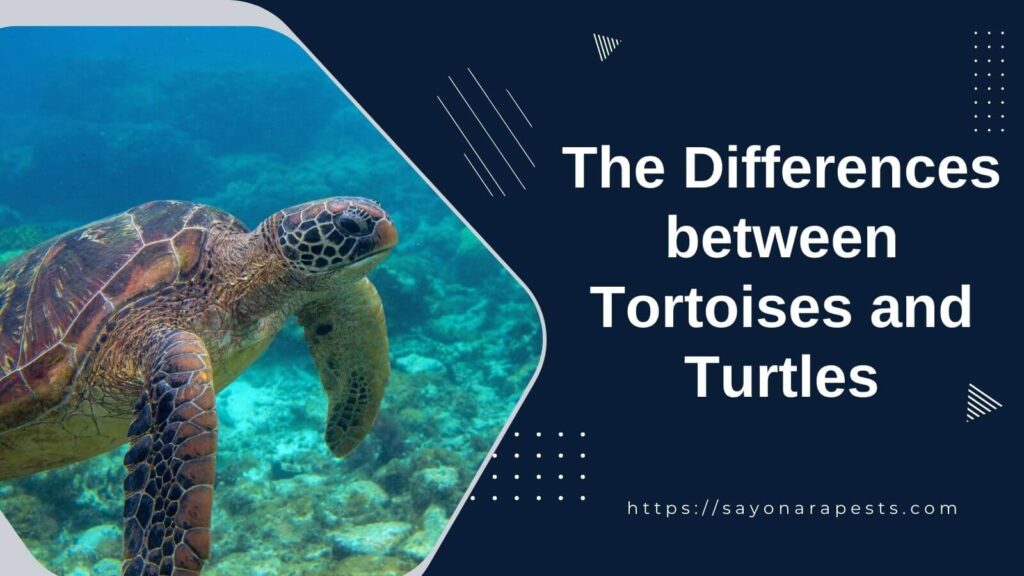The world of reptiles is full of interesting species that have captured the attention of both scientists and people who love nature. Tortoises and turtles are two reptiles that often make people wonder and get them interested.
Even though these creatures have some things in common, they also have things that make them different. In this article, we’ll learn more about these animals with shells by looking at how their bodies and environments are different.
By knowing the differences between tortoises and turtles, we can better understand how they have adapted to their environments and help protect them.
The main goal of this article is to explain how tortoises and turtles are different from each other. People often use the words “tortoise” and “turtle” interchangeably, but they are not the same thing.
By explaining the differences between these two groups, we can clear up misunderstandings and help people who are interested in reptiles or may meet them in different places get the right information.
This is important because it lets us respect the needs and behaviors of these amazing animals, making sure they stay healthy both in the wild and in captivity.
Because of how they affect the environment, it is very important to know how tortoises and turtles are different. Each of these reptiles lives in a different niche or environment and has its own set of adaptations to help it survive.
By knowing these differences, we can better understand how important these animals are to the delicate balance of ecosystems.
Also, this information can help guide conservation efforts and help scientists and environmentalists come up with good ways to protect tortoises and turtles from habitat loss, pollution, and other dangers they face in the modern world.
In the sections that follow, we’ll talk more about how tortoises and turtles are different, including how they look, where they live, what they do, and how they’ve changed over time.
Through this investigation, we’ll learn about the fascinating differences between tortoises and turtles, which are both reptiles.
So let’s start this journey of discovery by diving into the world of tortoises and turtles and finding out what’s going on under their shells.
Overview of Tortoises and Turtles
Tortoises and turtles are fascinating animals that have drawn people’s attention for hundreds of years. The order Testudines, which these reptiles are in, is one of the oldest groups of reptiles.
It dates back to the time of the dinosaurs. Both tortoises and turtles have a hard shells, scaly skin, and a slow pace of life, among other things. But there are some major differences between these two interesting species.
To understand what tortoises and turtles are, it’s important to know what each word means. Tortoises are land-dwelling reptiles that have evolved to live on land.
They are known for their high-domed shells and long, elephant-like legs, which help them move around and find food in different types of land environments. Tortoises are mostly herbivores, which means they eat plants, and their strong bodies make them well-suited to life on land.
Turtles, on the other hand, are aquatic or semi-aquatic reptiles that spend a lot of time in the water. They can move gracefully through rivers, lakes, and oceans because their shells are smooth and their legs are like paddles.
Turtles have changed to live in water. Their webbed feet make it easier for them to swim. Turtles have a more varied diet than tortoises do. They eat everything from plants and algae to small aquatic animals.
A quick look at the history of tortoises and turtles shows that they have been around for a long time and can be found all over the world. Fossils show that these reptiles have been around for more than 200 million years.
Over that time, they have changed and adapted to different environments. Tortoises, in particular, have been known to live in Africa, Asia, and the Americas in the past.
They have even been found on remote islands like the Galapagos, where they went through their own special ways of evolving.
Turtles also have a long history, and fossils show that they lived in many different places. Some turtles from the past were so big that they dwarfed even the biggest turtles today.
People have valued tortoises and turtles for their meat, shells, and symbols since the beginning of time. Different cultures have respected them and seen them as signs of long life, wisdom, and strength.
Even though tortoises and turtles are both reptiles, there are some major differences between the two. The most obvious difference is where they like to live.
Tortoises live mostly on land, while turtles live in water or places that are mostly water. This difference has changed their bodies and the way they act.
Tortoises have shells that are heavier and stronger to protect them on land, while turtles have shells that are more streamlined for swimming.
The food they like to eat is another big difference. Tortoises are herbivores, which means that most of what they eat is plants.
They have teeth that are designed to grind up plant matter, which lets them eat tough plant matter. Turtles, on the other hand, can eat both plants and animals, depending on the species.
They can catch prey with their sharp beaks or eat aquatic plants, which shows how well they can adapt to different food sources.
Also, their limbs and the way they move are different. Tortoises have short, stumpy legs that are good for walking on land but not so good for swimming.
Turtles, on the other hand, have paddle-like legs and webbed feet that make it easy for them to move through the water. These differences in appearance show how different these reptiles’ lifestyles and ecological niches are.
Even though tortoises and turtles have some things in common, they are different animals with different adaptations and roles in the environment.
Understanding the difference between tortoises and turtles, learning about their history, and noticing the main differences between them can teach you a lot about how complicated and varied the natural world is.
Scientists and fans are still interested in these reptiles, which show how many different kinds of life there are on Earth.
Differences Between Tortoises and Turtles in Physical Characteristics
Shell Structure
The shape of their shells is one of the most obvious ways to tell a tortoise from a turtle. Even though both animals have shells, their shapes and materials are very different. Tortoises have a shell that is mostly in the shape of a dome.
This gives them a lot of protection. This shell is shaped like a dome, which lets them pull all of their limbs and head into the shell, making it a safe and impenetrable fortress against possible predators.
Turtles, on the other hand, tend to have shells that are flatter and more streamlined. This shape makes it easier for them to move through the water, so they can swim more quickly and efficiently.
Turtles have a flatter shells because they live in water, which makes it easier for them to move through the depths.
Limb Structure
Aside from the way their shells are made, the way their legs are made is another major difference between tortoises and turtles. Tortoises usually have short, strong legs that help them get around on land, where they live.
These legs are made for walking and crawling on land. They give tortoises the stability and strength they need to move across a variety of surfaces.
On the other hand, turtles’ limbs have changed over time to become flippers, which helps them do well in water.
These flippers are long, slim, and have webbed tips, which help them move quickly through the water. Turtles can swim quickly and easily through oceans, rivers, and lakes because their legs are designed to help them do so.
Head and Neck Structure
Tortoises and turtles also have different heads and necks. Tortoises are easy to spot because their necks are short and thick, and they often pull them back into their shells.
Tortoises can protect themselves from possible dangers and keep a defensive stance because they can pull their necks back. This ability to pull their necks back is especially important for tortoises because it gives their vulnerable heads an extra layer of protection.
Turtles, on the other hand, have longer necks that are better for their semi-aquatic lives. Turtles’ long necks let them reach plants above the water’s surface, making it easier for them to eat.
Turtles’ longer necks also help them catch prey or avoid being eaten while they are underwater.
Tortoises and turtles look different in a number of ways that set them apart from one another. The shape of the shell is the main way to tell them apart. Tortoises have dome-shaped shells for protection on land, while turtles have flatter shells for better movement in the water.
The way their legs are built also makes them different. Tortoises have strong legs for walking on land, while turtles have streamlined flippers for swimming.
Lastly, the head and neck structures are different. Tortoises have short necks that can be pulled back for defense, while turtles have long necks that help them eat and move around in the water.
These unique physical features show how amazing it is that tortoises and turtles have been able to adapt to their environments.
Differences Between Tortoises and Turtles in Behavioral Characteristics
Even though tortoises and turtles look similar, they act in different ways that make them different from each other. Where they like to live is a big difference between them.
Tortoises are land animals that live mostly on land, while turtles are mostly aquatic animals that live in freshwater or the ocean. This difference in where they like to live has a direct effect on how they act and live.
When it comes to moving around, tortoises usually have strong, elephant-like legs that are made for walking on land. Their slow, deliberate movements show that they are land animals, as they move through different terrains with great patience and accuracy.
On the other hand, turtles are slim and have webbed feet or flippers that help them move quickly through the water.
Their graceful and agile movements below the surface show how good they are at swimming. This lets them move quickly and gracefully through oceans, rivers, and lakes.
Diet and Eating Habits of Tortoises and Turtles
There are also big differences in what tortoises and turtles eat and how they eat. Most tortoises are herbivores, which means they eat plant matter like grasses, leaves, and fruits.
Their strong beaks and jaws are made so that they can crush and grind plant material. On the other hand, turtles have a wider range of ways to eat. Some species only eat plants, but others eat everything or even meat.
Herbivorous turtles eat aquatic plants and algae, while omnivorous and carnivorous turtles eat insects, fish, and even small mammals.
Reproduction of Tortoises and Turtles
Tortoises and turtles also behave differently when it comes to reproduction. Tortoises have complicated courtship rituals to attract potential mates.
Some of these rituals include bobbing the head, circling, and being aggressive, all of which are meant to impress and win over a potential partner.
Turtles, on the other hand, have a less complicated way of showing they are ready to mate. They mostly use visual displays and pheromones.
Female turtles usually lay their eggs on land, in nests they dig with their back legs. Tortoises also lay eggs, but usually in nests that the female digs with her back legs.
Overall, the ways tortoises and turtles act show how well they have adapted to their different environments and ways of life. Tortoises do well on land because they move slowly and eat plants.
Turtles, on the other hand, do well in water because they have streamlined bodies and eat different things. These differences also show up in how they try to get a mate.
Tortoises have complicated courtship rituals, while turtles use body language and smell to talk to each other.
By learning about these differences in behavior, we can learn more about how different and adaptable these fascinating reptiles are.
Differences between Tortoises and Turtles in their Habitats
When you look at where tortoises and turtles live, it’s clear that these amazing animals can do well in many different places. Tortoises and turtles are both reptiles in the order Testudines, but they have different needs when it comes to where they live. Understanding the differences in the places they choose to live helps us understand how their bodies and behaviors have changed.
Types of Habitats
First, let’s talk about the kinds of places tortoises and turtles like to live. Tortoises are mostly land animals that live in dry places like deserts, grasslands, and scrublands.
These places give them plenty of places to soak up the sun and lots of grassy plants to eat. Tortoises do well in these dry areas because they can keep water in their bodies and live in places where there isn’t much water.
Turtles, on the other hand, spend most of their time in water or near water. They live in rivers, ponds, lakes, oceans, and other bodies of water. They can also be found on land near bodies of water.
Turtles can move quickly and easily through water because their shells are smooth and their feet are webbed.
Differences in habitat requirements between tortoises and turtles
Also, tortoises and turtles need different kinds of habitats, which shows that they like different things. Tortoises are reptiles that live on land, so they need places where they can dig holes and where there is a lot of food, like plants.
They often hide in burrows to avoid extreme heat and keep their body temperature stable. Grass, cacti, and shrubs, among other types of plants, are very important to their diet. On the other hand, turtles can’t live without water.
They need aquatic or semi-aquatic habitats with clean, easy-to-reach water to drink, eat, and have babies. How healthy they are as a whole depends a lot on the quality and temperature of the water.
How Habitat Affects the Behavior of Tortoises and Turtles
Both tortoises and turtles are very affected by their environment in ways that go beyond where they live. Tortoises have developed certain habits to help them live in their dry environments.
Their slow movements and ability to hide in their shells help them save energy and stay safe in the open terrain.
Their eating habits depend on what plants are around. Some tortoises are opportunistic herbivores that eat a wide range of plants, while others may be more picky about what they eat.
Turtles, on the other hand, do many different things because they live in water or near water. They swim well and can dive in a way that is very impressive.
They do things like lie in the sun to control their body temperature, travel long distances to find good places to nest and perform courtship rituals to make sure they can have babies.
In the end, there are big differences between where tortoises and turtles live. The majority of tortoises live on land, where they have to deal with dry conditions and rely on plants and burrows for food and shelter.
Turtles, on the other hand, live mostly or mostly in water and need clean water to live. They have different parts that help them swim and dive. The preferences and needs of these reptiles’ habitats have a big impact on how they act.
For example, tortoises use energy-saving strategies and choose what they eat, while turtles are good at swimming, travel long distances, and have elaborate mating rituals.
By learning more about their complex habitats and behaviors, we can better understand the wide range of species in the order Testudines and the interesting ways in which they have adapted to their environments.
Population and Distribution of Tortoises and Turtles
The number of tortoises and turtles and where they live are interesting facts about their natural history. These amazing reptiles live in different parts of the world, and each one has a different geographic range.
When you look at where tortoises live, you can see a fascinating tapestry of places where these ancient animals do well.
Geographic Distribution of Tortoises
Tortoises are known for living on land, and most of them live in dry, arid places around the world. They live in deserts, like the Sonoran Desert in North America, the Sahara Desert in Africa, and the Australian Outback.
Their ability to adapt to harsh conditions shows how strong they are. Some species, like the Galapagos tortoise, have even changed to be able to live on harsh islands.
Geographic Distribution of Turtles
On the other hand, turtles are found in a wider range of places, with some species living both on land and in water. Turtles live in many different kinds of freshwater lakes, rivers, ponds, and even the ocean.
Turtles that live in freshwater live in the Great Lakes in North America, the Amazon River in South America, and the Ganges River in Asia.
Turtles that live in the ocean, like the loggerhead and the green sea turtle, swim through huge oceans and lay their eggs on sandy beaches all over the world.
Even though tortoises and turtles live in different parts of the world, they also share some habitats. For example, the African spurred tortoise lives in both arid grasslands and semiarid areas, while freshwater turtles can be found in lakes or ponds nearby.
Most of the time, these ranges overlap because there are good resources, like food and water, in certain areas.
Differences in Distribution between Tortoises and Turtles
Tortoises and turtles live in different places because their bodies have changed and they have different ecological preferences. Tortoises can live in deserts where water sources are scarce because they can store water and deal with dry conditions.
On the other hand, turtles can swim because their bodies are slim and their feet are webbed. This means that they can live in water.
The history of how these reptiles have changed over time has also affected where they live. Tortoises are thought to have split off from a common ancestor before turtles did, which is why they are found in fewer places on land.
Turtles have been around for a shorter amount of time than most other animals, so they have been able to live in both land and water environments.
Tortoises and turtles need to be saved, so it’s important to know how many there are and where they live. These species are in danger because of things that people do, like destroying their habitats, making the environment dirty, and trading illegally.
Conservationists can make plans to protect their habitats and ensure their long-term survival by mapping their ranges and keeping track of their populations.
The number of tortoises and turtles and where they live tell us a lot about the ecological diversity of these amazing reptiles. Their unique adaptations and ecological preferences are reflected in where they live.
Tortoises do well in dry areas, while turtles can live in both water and on land. There are differences in where these reptiles live, but there are also places where their ranges overlap.
Understanding these patterns is important for protecting them, and it’s a good way to remember how closely species and their environments are linked.
Threats and Conservation of Tortoises and Turtles
Threats to tortoises and turtles
Tortoises and turtles are ancient and interesting animals that have lived on Earth for millions of years. In the modern world, they face many threats that put their survival at risk.
These amazing reptiles, which are known for moving slowly and steadily and having unique shells, face a number of problems that have brought many species close to extinction.
Tortoises and turtles are most at risk when their homes are destroyed. The constant growth of the human population and the demand for resources that comes with it has destroyed and broken up their natural habitats.
Wetlands, coastal areas, and ecosystems on land that are important for their survival are being changed quickly for agricultural, urban, and industrial uses. This makes it harder for them to eat and breed, which makes them more vulnerable to other threats.
Poaching and the illegal trade of wildlife are also major threats to these reptiles. In some cultures, people want tortoises and turtles for their meat, shells, and other parts of their bodies that they think have medicinal or decorative value.
Poachers take advantage of this demand and often use cruel and unsustainable ways to catch and move these animals. The illegal trade not only hurts populations but also helps fund organized crime networks, which makes it very hard to protect wildlife.
Tortoises and turtles face more danger in the form of climate change. Rising temperatures, changes in how it rains, and rising sea levels all have direct effects on their habitats. Some turtle species can tell if a hatchling is a boy or a girl based on the temperature.
This means that even small changes in temperature can change the ratio of boys to girls in a population. The warming of the oceans also affects their food sources and messes up their migration patterns, making them confused and hard-pressed to stay alive.
Conservation Efforts
Tortoise and turtle populations are being protected and brought back to health through conservation efforts all over the world.
International groups, governments, and passionate people are working together to make plans that include protecting habitats, enforcing the law, raising public awareness, and doing scientific research.
Protecting their habitat is a very important part of keeping these reptiles alive. Protected areas, like national parks and reserves, are safe places where tortoises and turtles can live and grow without having to worry about their habitats being destroyed or being bothered by people.
These areas are meant to protect the important ecosystems on which these animals depend, making sure they have enough food, places to nest and places to breed.
Law enforcement is another important part of efforts to protect the environment. Poaching and illegal trade in wildlife are being stopped by governments by making laws stronger and giving offenders harsh punishments.
Law enforcement agencies, non-governmental organizations, and local communities must work together if they want to break up illegal networks and shut down the markets that fuel the trade.
Public awareness campaigns are a big part of changing the way people think and act about these animals.
Communities need to know how important tortoises and turtles are to ecosystems, what their cultural and ecological value is, and why they need to be protected.
By making people more empathetic and understanding, these campaigns help people make better decisions and support conservation efforts.
Success Stories
Even though there have been many problems, tortoises and turtles have been saved in some important ways.
For example, the Galápagos tortoise was once on the verge of going extinct, but it has made a remarkable comeback thanks to efforts to restore its habitat and start breeding it in captivity.
In a similar way, the population of the Kemp’s ridley sea turtle, which is the most endangered species of sea turtle, has grown thanks to programs to protect nests and limits on fishing.
The dangers tortoises and turtles face are many and serious, but there is hope if people work hard to protect them.
We can try to make sure that these ancient animals will be around for future generations by stopping the destruction of their habitats, stopping the illegal trade in wildlife, and reducing the effects of climate change.
The success stories remind us of the good things that can come from conservation efforts and encourage us to keep working together toward a peaceful and sustainable future with these amazing reptiles.
In the end, it’s important to review the differences between tortoises and turtles to get a full picture of these amazing animals.
During this investigation, we have looked at many of the things that make them different, such as their habitat, physical features, and behavior. By thinking about these differences again, we can see how unique each species is and how important it is to save and protect them.
Tortoises and turtles live in very different kinds of places. Tortoises are mostly land animals that live in deserts, grasslands, and forests, among other places. They have changed to be able to live on land and have strong legs and feet that let them move through different terrains.
Turtles, on the other hand, spend most of their time in freshwater like lakes, rivers, and ponds. Their bodies are streamlined and their feet are webbed to help them swim quickly and move around in the water.
The way tortoises and turtles look is another important way to tell them apart. Tortoises’ shells are usually in the shape of a dome, which is a great way to keep predators away.
Most of the time, their shells are heavier and more durable, which helps them survive in the harsh conditions of the land.
Turtles, on the other hand, have shells that are more streamlined, making them lighter and better at moving through water. This change in their bodies lets them move gracefully through the water where they live.
Also, the way tortoises and turtles act shows how different their lives are. Tortoises are known for moving slowly and deliberately, which makes sense since they live on land.
They eat plants and lie in the sun to save energy. This is how they spend a lot of their time.
On the other hand, turtles are faster and more active in water. They swim well, diving and coming back up for air. Some species even travel long distances on epic migrations.
Several things make it very important to understand these differences. First of all, it helps identify and group species, which is important for biology and ecological research.
By telling the difference between tortoises and turtles, scientists can improve their studies and learn more about how each species lives, where it lives, and how it interacts with its environment.
This information is the basis for conservation efforts and management plans that are well thought out.
Second, noticing the differences between tortoises and turtles helps build a sense of awe and wonder for the natural world. Their different ways of living and adapting show how diverse life is on our planet.
By learning more about the details, we can feel more connected to these animals and the ecosystems they live in, which will make us feel more responsible for protecting them.
In conclusion, the world of tortoises and turtles is fascinating and full of differences that show how beautiful diversity is.
By learning about the different places these amazing animals live, how they look, and what they do, we can learn more about the natural world and grow a deeper appreciation for its complexity.
By appreciating these differences, we can help protect and preserve tortoises and turtles, making sure they will be around for future generations.











